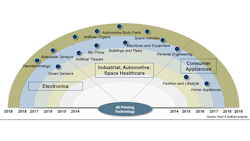4D printing develops materials that can change properties and characteristics based on changes in the environment—like temperature. The changes could let materials self-assemble thus speeding up manufacturing and reducing labor requirements.
4D technology and equipment is expected to grow rapidly in the healthcare, aerospace, defense, and automotive industries after it’s commercialization, according to a market-research report by Frost & Sullivan, Advances in 4-D Printing. The report also says that 4D printing faces several long-term and short-term challenges including high initial costs and the need for standardization. 4D printing could create a range of products from automotive parts to human organs. Benefits of 4D printing include: increased capabilities of the printed products; new applications from adaptive materials; added manufacturing efficiency; and, reduced manufacturing cost and carbon footprint.
The healthcare market could use the technology for tissue engineering, self-assembling biomaterials, and creating nanorobots for chemotherapy. For the automotive industry, 4D printing could lead to coatings that adapt to sun, wind, and rain. The aerospace market might benefit from 4D printing by way of self-repairing parts or planes and printed solar panels to power satellites. Potential innovations in the military and defense sector includes textiles with camouflage capabilities and self-healing materials for bridges and temporary roads.
The major challenge in the short-term for 4D partsis the high initial costs partially due to there being only a few companies currently developing techniques that support 4D. However, after commercialization the cost of 4D printing should come down. Long-term, 4D parts will need to meet regulatory and performance standards in various industries before it becomes widespread.
About the Author
Sarah Mangiola
Sarah Mangiola has written on many different topics within Penton's Design, Engineering, and Sourcing Group. Originally from California, she graduated from the University of California, Davis with a B.A. in political science.

